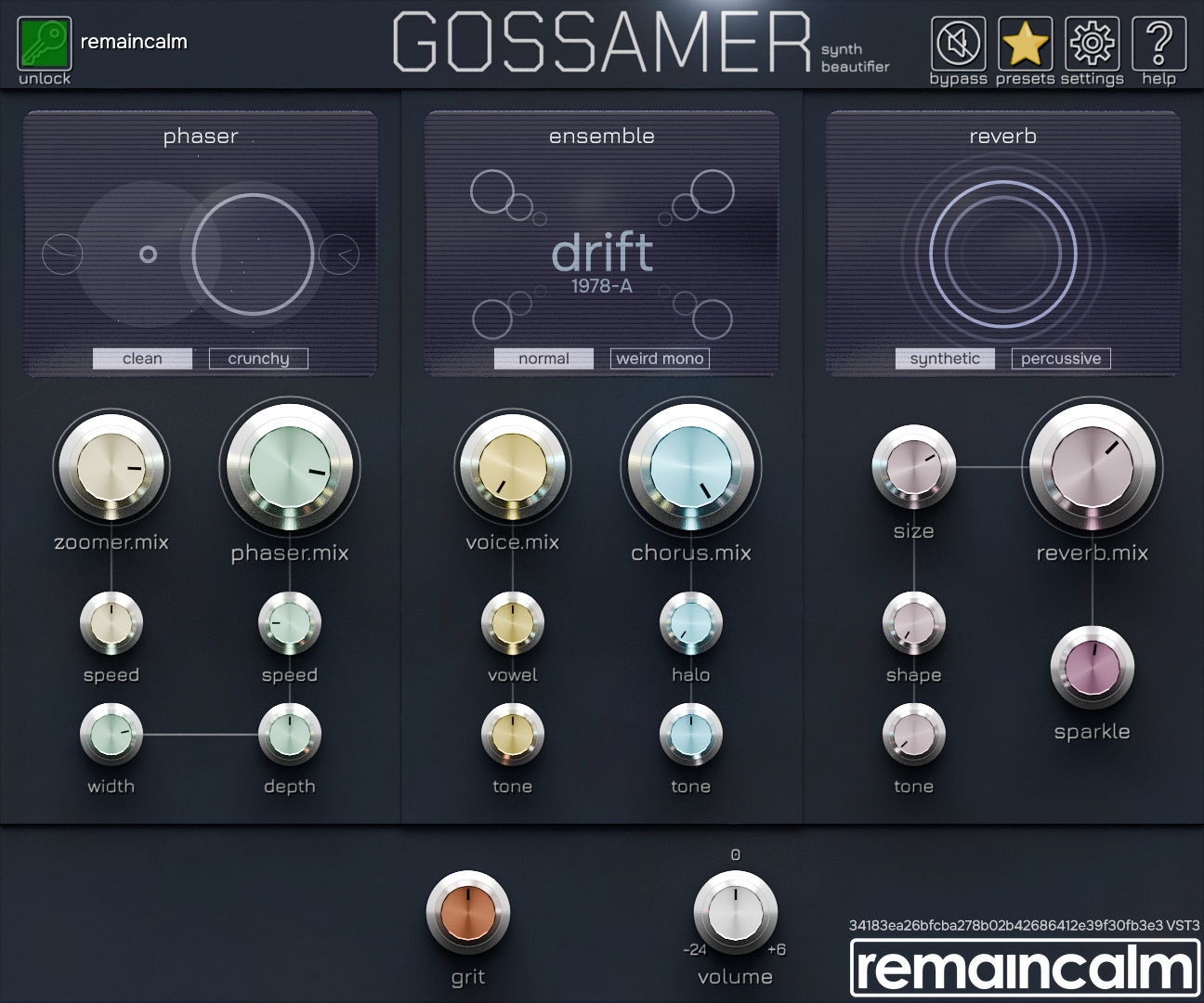remaincalm GOSSAMER is a powerful circuit-modelled multi-effect, designed to be the ultimate modulation tool for synth, strings and vocals.

This is brand-new software. While utmost care has been taken, please watch out for issues and report anything you see to support@remaincalm.org. Please exercise caution. Please do not distribute. Thanks!
Registration
Click the key icon (top-left) and paste in the whole registration code you received via email. Your name will be shown on the plugin screen. Contact support@remaincalm.org if you run into any issues.If unregistered, the plugin will not save any settings or presets, and a weird noise will interrupt playback from time to time.
We've chosen to use a user-friendly, minimally-intrusive registration system that doesn't rely on remote servers. Please don't distribute registration codes. Thanks.
Signal Chain
GOSSAMER contains multiple processors optimized for big synth sounds but also useful on many other sources.The global tone and grit controls affect the sound across most of these processors.
Details
The zoomer effect is a flanger inspired by sounds of early 2000s French house music.
The formant filter is an array of bandpass filters inspired by a 1970s Japanese vocoder, but has been tuned to be more flexible.
The ensemble effect crossfades between chorus models inspired by classic "string" synths. Some settings run up to eight chorus lines in parallel, creating a luxuriously rich ensemble effect on any source. The tone and grit controls have a large effect on the sound of this module. The models are inspired by:
- driftlate-1970s Japanese string synth, mode I, quad-BBD
- spinlate-1970s Japanese string synth, mode II, quad-BBD
- arccustom quad-BBD circuit
- homeearly-1970s European string synth, tri-BBD
- flatmid-1970s Japanese string synth, dual-BBD
- heatcustom tri-BBD circuit
- glowmid-1970s European string synth, tri-BBD
- neonearly-1980s Japanese subtractive synth, dual-BBD
- glazeearly-1980s Japanese stompbox
The phaser effect began as a model of a rare 1970s standalone processor used on many classic European electronic releases, but has been extensively modified.
The reverb is optimized for expansive synth sounds, although it can also be used for medium room and plate effects. The 'shape' control crossfades between an enormous complex space to a more reflective, rectangular space. At lowest settings, the reverb becomes a modulated slapback delay that sounds great on vocals. In this mode, the 'shape' parameter controls the chorus/delay mix.
Clicking on the reverb display toggles 'percussion mode', which tightens up the reverb by reducing pre-delays, reverb time, and chorusing.
Clicking on the phaser display enables an aggressive 'crunchy' mode with higher resonance and feedback, increased noise and distortion, and improved circuit emulation - CPU usage is roughly double normal mode. Exercise care! The circuit this is based on can go into angry feedback with some sources.
Clicking on the ensemble display enables a subtractive mono mode on the chorus stage which works like an unusual phaser.
Controls
Phaser Section
Phaser and flanger effects. Click screen to toggle additional gain and improved overdrive, feedback and opto model in the phaser emulation. Interactive with 'grit' control.
- zoomer.mixControls intensity of a delay-based 'disco' flanger.
- zoomer.speedControls speed of the flanger effect.
- phaser.mixControls intensity of a vintage optical phaser effect. Modulation depth and phaser feedback change across the mix range. Sounds best at 40% and 100%.
- phaser.speedControls speed of the phaser effect. Resonance increases at lower speeds.
- phaser.depthControls phaser character and depth of the phaser modulation. Modulation control signal saturates at top of range. Interactive with grit control.
- phaser.widthControls stereo spread of the phaser effect.
Ensemble Section
Formant and ensemble chorus effects. Interactive with 'grit' control. Click to toggle a 'faulty stereo output jack' mode in the ensemble model.
- voice.mixControls intensity of a vocal formant effect.
- voice.vowelChanges the formant filter 'vowels'.
- voice.toneChanges the tonal balance of the formant filter.
- chorus.mixControls intensity of an ensemble chorus effect. Usually sounds best at 100%.
- chorus.haloCrossfades between chorus algorithms. Models are inspired by classic 1970s synths. Shift-drag to snap to single model.
- chorus.toneControls tonal balance of chorus effect.
Reverb Section
Reverb and shimmer effects. Operates as a chorus/slapback delay at lowest size. Click to toggle a tighter 'percussion' mode with shorter delays and reduced detuning.
- reverb.mixControls send level and mix of a modulated reverb effect optimized for synth sounds. The reverb has a ducking effect which increases intensity at low values.
- reverb.sizeControls delay/reverb size and tone. Sweeps from 'radioactive vocal booth' to 'executive bathroom' to 'alien cathedral'. Low values activate an alternate chorus/delay mode.
- reverb.shapeControls reverb 'shape'. Low values model weird, connected spaces. High values model brighter, cleaner rooms.
- reverb.toneControls tone of reverb effects.
- sparkleAdds 'octave up' granular processing to the reverb. Sounds best at 50% with evolving synth sounds.
Global Section
- gritControls saturation, noise and circuit imperfections. Interacts with phaser, chorus and formant modules. Low values change phaser feedback network.
- levelControls overall volume of the unit.
Settings
Click the gear icon to open a settings screen.Presets
Click the star icon to try out some presets.Bug Reports
Please email support@remaincalm.orgLegal
Full legal agreement is in the installer EULA and about page of the plugin. Additional license info is in the about page of the plugin. Additional legal and privacy info is available at the bottom of this page.
